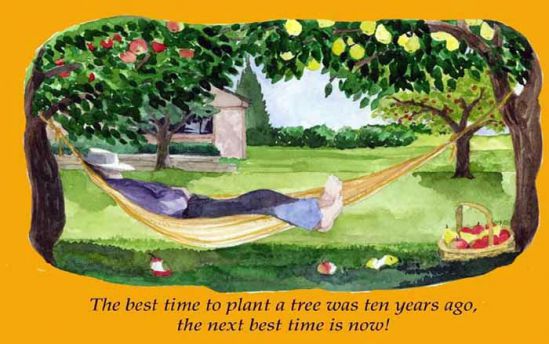How to Create a Food Forest

A core concept of Permaculture is the use of perennial polycultures to replace or compliment annual agriculture. From the the ancient forests of Europe and Asia to the Dust Bowl of the US, and the monocropped soy plantations of Brazil, annual grain-based agriculture applied on a landscape level has a long track record of deforestation, soil erosion and desertification. Food forests, agroforestry, forest farming and perennial polyculture are all variations of a theme of utilizing a diversity of perennial plants to supply basic human needs of food, fuel, fodder and soil fertility. These perennial systems conserve and build soil while producing fruits, nuts, animal feed, building materials and mulch. By mimicking a natural forest it is possible to close the nutrient cycle and reduce or eliminate the need for external inputs like fertilizers and irrigation, thereby reducing the carbon footprint of agriculture while improving local self-reliance.
Work your way through the list in the right sidebar. You can go in order or skip over topics you already know. Whether you are planning a multi-layer food forest or a simple home orchard, this process will help you to choose the right plants for your location and design a layout that fits your site.
More Links
The UC Davis California Garden Web has a website on growing fruit & nut trees & vines.
Grafting
Principles of Grafting and Budding - If you want the full scoop on grafting, the why as well as the how, then this chapter on grafting, posted by UC Davis, is a good, comprehensive overview of grafting principles and techniques.
Grafting and Propagating Fruit Trees - This pamphlet by Penn State boils it down to the basics of how to graft using a variety of techniques. ( Good photos, but most professional grafters use a different hold on the knife).
Grafting Fruit Trees - This is a useful Power Point presentation by Lloyd Collet of Oregon State University - nice photos of the step-by step processes involved in a variety of grafts.
Pruning
Pruning Manual by Dan Lurie, Filoli Gardens Newsletter - This is the best pruning manual we've seen. Divided into three sections - Principles of Tree Growth, Training Young Trees, and Pruning Mature Trees, published in The Sundial, a newsletter of Filoli Gardens.
Pruning to Restore an Old, Neglected Apple Tree, by R. L. Stebbins and J. Olsen, Oregon State Univertity - This completes the manual above by showing how to restore an old tree that has not been pruned for years; (hint: it takes a few years). Follow this simpe, concise guide for good results.

